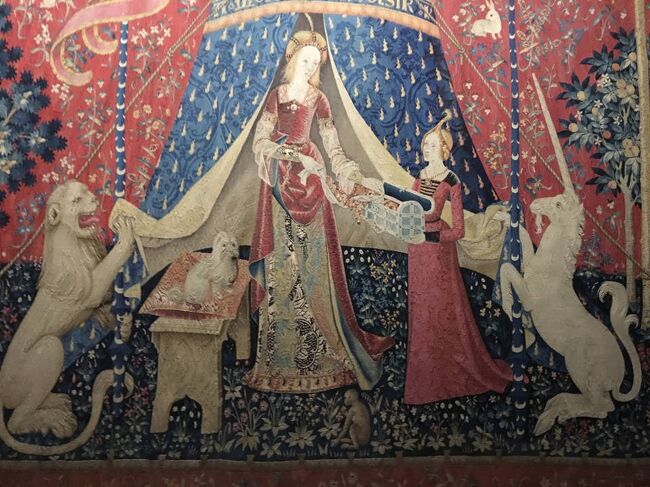
2019/11/30 - 2019/12/03
3696位(同エリア17042件中)
![]()
something like thatさん
- something like thatさんTOP
- 旅行記357冊
- クチコミ161件
- Q&A回答1件
- 350,044アクセス
- フォロワー24人
この旅行記スケジュールを元に
パリ滞在3日目 前半
カバー写真は、タペストリー『貴婦人と一角獣』の「我が唯一の望みに」
今回は、ガンダムユニコーンの聖地巡礼です。
サクレ・クール寺院
Sacré-Cœur
壁抜け男
Le Passe-Muraille
ジュテームの壁
Le Mur des Je t'aime
国立中世美術館 ― クリュニー浴場および館
Musée national du Moyen âge - Thermes et Hôtel de Cluny)
略称「国立中世美術館」; 通称「クリュニー美術館 (Musée de Cluny)」
https://www.musee-moyenage.fr/en/
- 旅行の満足度
- 4.5
- 観光
- 4.5
- 同行者
- 一人旅
- 交通手段
- 徒歩
- 旅行の手配内容
- 個別手配
-
サクレ・クール寺院
Basilique du Sacré-Cœur
同じ名前の教会堂は多く存在するが、フランス語で、「聖なる心臓」(聖心)を意味し、イエス・キリストの聖心に捧げられたことを意味する。
モンマルトルの丘に上に建っているので登っていきますが、近くにみえるようで意外に遠い。 -
サクレ・クール寺院
Basilique du Sacré-Cœur
建築様式は一見、古く見えますが、近代のもの(完成は第一次世界大戦後)です。
このドーム部の背の高さは中世では無理じゃないかな。 -
サクレ・クール寺院
Basilique du Sacré-Cœur
モンマルトルのサクレ・クール寺院(フランス語: Basilique du Sacré-Cœur de Montmartre)は、フランスのパリ市内18区モンマルトルの丘の頂にそびえる教会堂。ロマネスク様式・ビザンティン様式のバジリカ大聖堂。ギベール・パリ大司教が計画を提唱。ペリグーのサン=フロン大聖堂をモデルにポール・アバディが設計を担当した。1889年にいち早く完成していたエッフェル塔と共にパリ市内を見晴らせる観光名所で、両建造物とも19世紀後半に構想された比較的新しいものであるにもかかわらず、今やパリになくてはならない存在になっている。
第三共和政の憲法が発布された1875年に、フランスの新しい政体の門出を祝う意味合いを籠めて、政府による直接的な支援を受けて建設がはじまった。当時は普仏戦争とそれに続くパリ・コミューンによって命を失ったフランス市民を讃える公共建造物としても考えられていたが、年月が過ぎるにつれてその位置づけが自ずと変容してしまう。実際に着工したのは1877年で、約4000万フランの費用と40年の歳月をかけ、1914年に完成したものの、礼拝のために開放されたのは第一次世界大戦の終わり、1919年のことであった故に、この寺院は皮肉にも普仏戦争以来のドイツに対する復讐の象徴として多くのフランス人から捉えられた。
教会の鐘は通称サヴォアと呼ばれ、1895年にサヴォワ地方で造られた。重さ約18トンの、世界最大級の鐘である。
(wikiより) -
サクレ・クール寺院
Basilique du Sacré-Cœur -
サクレ・クール寺院
Basilique du Sacré-Cœur -
サクレ・クール寺院
Basilique du Sacré-Cœur
まだ、朝早いためか、階段に座っている人は少なめかと。 -
サクレ・クール寺院
Basilique du Sacré-Cœur
https://www.sacre-coeur-montmartre.com/ -
サクレ・クール寺院
Basilique du Sacré-Cœur
モンマルトルの丘からのパリの眺め。霞みがかっていますが一望できます。 -
サクレ・クール寺院
Basilique du Sacré-Cœur
中に入ります。無料です。 -
サクレ・クール寺院
Basilique du Sacré-Cœur
主祭壇の上にあるビザンティン様式っぽいモザイク、両手を広げたキリスト。サクレクール寺院 寺院・教会
-
サクレ・クール寺院
Basilique du Sacré-Cœurサクレクール寺院 寺院・教会
-
サクレ・クール寺院
Basilique du Sacré-Cœur -
サクレ・クール寺院
Basilique du Sacré-Cœur -
サクレ・クール寺院
Basilique du Sacré-Cœur -
サクレ・クール寺院
Basilique du Sacré-Cœur -
サクレ・クール寺院
Basilique du Sacré-Cœur -
サクレ・クール寺院
Basilique du Sacré-Cœur -
サクレ・クール寺院
Basilique du Sacré-Cœur -
サクレ・クール寺院
Basilique du Sacré-Cœur
模型。見る方向で寺院の印象が変わります。 -
サクレ・クール寺院
Basilique du Sacré-Cœur -
サクレ・クール寺院
Basilique du Sacré-Cœur -
サクレ・クール寺院
Basilique du Sacré-Cœur
ステンドグラスから差し込む光で溢れています。 -
サクレ・クール寺院
Basilique du Sacré-Cœur -
サクレ・クール寺院
Basilique du Sacré-Cœur -
サクレ・クール寺院
Basilique du Sacré-Cœur -
サクレ・クール寺院
Basilique du Sacré-Cœur
うまく差し込む光が像に当たるように考えられているんだ。 -
サクレ・クール寺院
Basilique du Sacré-Cœur -
サクレ・クール寺院
Basilique du Sacré-Cœur -
サクレ・クール寺院
Basilique du Sacré-Cœur -
サクレ・クール寺院
Basilique du Sacré-Cœur -
サクレ・クール寺院
Basilique du Sacré-Cœur -
サクレ・クール寺院
Basilique du Sacré-Cœur -
サクレ・クール寺院
Basilique du Sacré-Cœur -
サクレ・クール寺院
Basilique du Sacré-Cœur -
サクレ・クール寺院
Basilique du Sacré-Cœur -
サクレ・クール寺院
Basilique du Sacré-Cœur -
テルトル広場
Place du Tertre
この辺りは芸術のまち。今も絵を売る人がいます。
お洒落なカフェも立ち並ぶけど、まだ、昼前なので、、、パス。 -
ムーラン・ルージュは右らしいが、、、今回はパス。
-
壁抜け男
Le Passe-Muraille
たしか、この辺・・・と思っていたら、すぐ横にあった。 -
壁抜け男
Le Passe-Muraille
観光地としてそれほど認知されている訳でもなさそうで、人だかりはない。
みんな写真を撮っては足早に去っていく。壁ぬけ男 モニュメント・記念碑
-
壁抜け男
Le Passe-Muraille
壁に埋め込まれた男性の個性的な像。フランスの作家マルセル・エイメが1943年に書いた短編小説、短編集を基に制作された作品。題材にしたミュージカルもある。 -
壁抜け男
Le Passe-Muraille
新手のスタンド使い、、、ではない。 -
ジュテームの壁
Le Mur des Je t'aime
日本語は3つほど見つけた。
ここはカップルでくるところだね。愛しているの壁 (ジュ テームの壁) 文化・芸術・歴史
-
ジュテームの壁
Le Mur des Je t'aime愛しているの壁 (ジュ テームの壁) 文化・芸術・歴史
-
アベス駅
Abbesses
次の目的地に地下鉄で移動します。アベス駅 駅
-
国立中世美術館
Musée de Cluny - Musée national du Moyen Âge
国立中世美術館 ― クリュニー浴場および館
Musée national du Moyen âge - Thermes et Hôtel de Cluny)
略称「国立中世美術館」; 通称「クリュニー美術館 (Musée de Cluny)」
パリ5区(カルティエ・ラタン)にある美術館で、中世の絵画、彫刻、宝飾品(金銀細工、象牙細工、琺瑯)、装飾写本、ステンドグラスなどの宗教美術品、タペストリー、家具などの工芸品を所蔵・展示している。特に6枚の連作タペストリー『貴婦人と一角獣』、『黄金のバラ』、ガロ=ロマン時代の『船乗りの柱(フランス語版)』、柱頭、磔刑像・預言者像などで知られる。敷地はガロ=ロマン時代に建てられた浴場跡(クリュニー浴場)であり、クリュニー館と呼ばれる建物は13世紀にブルゴーニュのクリュニー修道会の修道院長の別邸として建てられ、15世紀に全面的に修復・改装され、ほぼ現在の形になった。浴場跡の一部は現在も展示室として使われ、建物外側にある部分はサン・ミシェル通りから見ることができる。常設展・企画展のほか、中世の楽器を使った音楽会なども行われている。
(wikiより) -
国立中世美術館
Musée de Cluny - Musée national du Moyen Âge
https://www.musee-moyenage.fr/en/クリュニー美術館 博物館・美術館・ギャラリー
-
国立中世美術館
Musée de Cluny - Musée national du Moyen Âge -
国立中世美術館
Musée de Cluny - Musée national du Moyen Âge -
国立中世美術館
Musée de Cluny - Musée national du Moyen Âge -
国立中世美術館
Musée de Cluny - Musée national du Moyen Âge
概要
美術館の延床面積は3,500m2。所蔵品は23,600点以上で、うち2,300点を展示している。展示室は23室あり、古代から初期中世、ロマネスク芸術、リモージュの琺瑯、ゴシック芸術、15世紀と時代ごとに分かれ、さらに、各時代について、コプト美術、初期の王国、ビュザンティオン、ローマ帝国、フランス、英国、イベリア半島、イタリア、スペイン、ゲルマン諸国、北欧諸国などの国・地域ごとに分かれている。タペストリー、ステンドグラスは専用の展示室がある。
(Wikiより) -
国立中世美術館
Musée de Cluny - Musée national du Moyen Âge
タペストリー
『貴婦人と一角獣』
「我が唯一の望みに」
このタペストリーの前に立った時、「おれ、ここを知ってる。この絵を見たことがある」と呟きました(笑)願わくば、ミネバが横にいてくれたら。
----------------------
ミネバ 「ユニコーン……」
バナージ 「"私の、たったひとつの望み"……」
ミネバ 「あなた、あれ読めるの?」
バナージ 「……! 何なんだこれ」
「おれ、ここを知ってる。この絵を見たことがある」
カーディアス 「お気に召しましたかな」
「『貴婦人と一角獣』。中世期以前にフランスで製作されたと思われるタペストリーです。レプリカではありません。一年戦争以前に、先代が苦労して手に入れました」
ということで宇宙世紀の時代には、コロニーにこのタペストリーが運ばれるようです。
--------------------
我が唯一つの望みに (À mon seul désir)
このタペストリーは他と比べて幅が広く、描かれた絵の様子も他と異なっている。他の5枚のタペストリーは描かれた仕草などから五感のアレゴリーだとされているが、この一枚は謎が多く、他の5枚の前の情景を描いたものか後の情景を描いたものかすら定かではない。「我が唯一つの望みに」で身支度をした後、嗅覚・味覚・聴覚でユニコーンをおびき寄せ、視覚と触覚でユニコーンを捕まえるまでを描いているという見方もあれば、五感でユニコーンを引き寄せた後、「我が唯一つの望みに」で身を整えてテントに入るという見方もある。
絵の中央には深い青色のテントがあり、その頂には金色で「我が唯一つの望み」(A Mon Seul Désir)と書かれている。テントの入り口の前に立つ貴婦人は、これまでの5枚のタペストリーで身に着けていたネックレスを外しており、右にいる侍女が差し出した小箱にそのネックレスを納めている(またはここではじめてネックレスを取り出し首につけようとしている)。彼女の左側にはコインが入ったバッグが低い椅子に置かれている。ライオンとユニコーンが貴婦人の両側で旗をささげ持っている。
この一枚のタペストリーはさまざまな解釈を引き出してきた。解釈の一つは、若い貴婦人がネックレスを小箱にしまっているのは、他の五感によって起こされた情熱を、自由意志によって放棄・断念することを示しているとする。別の解釈では、この場面は五感の後に来る「理解すること」という六番目の感覚を指しているという。また、愛や処女性、これから結婚に入ることを示しているという解釈も存在する。(wikiより) -
国立中世美術館
Musée de Cluny - Musée national du Moyen Âge
手鏡を持っているので、「視覚」
「視覚」(La vue)
このタペストリーでは、貴婦人は腰掛け、右手に手鏡を持っている。ユニコーンはおとなしく地面に伏せ、前脚を貴婦人のひざに乗せ、彼女の持つ鏡に映った自分の顔を見ている。左側にいるライオンは旗を掲げている手鏡を持っている。
タペストリー
国立中世美術館は特に6枚の連作タペストリー『貴婦人と一角獣』を所蔵していることで知られるが、他にも『荘園の暮らし』、『聖ステファノ伝』などの大きなタペストリーがある。パリでデザインされ、15世紀末のフランドルで織られたこのタペストリーは、1841年、歴史的記念物監督官であった小説家のプロスペル・メリメによりブーサック城(現在のクルーズ県)で発見された。生地を守るために光量を落とした円形の特別室に展示された6枚のタペストリーはすべて千花模様(ミルフルール)を背景に貴婦人と一角獣が描かれ、うち5枚はそれぞれ「視覚」「聴覚」「味覚」「嗅覚」「触覚」の寓意を示している。最後の1枚は「我が唯一の望みに」と題されているが、「我が唯一の望み」とは何なのか、その意味はいまだ謎に包まれている。
(Wikiより) -
国立中世美術館
Musée de Cluny - Musée national du Moyen Âge
楽器(パイプオルガン)を奏でているので、「聴覚」
「聴覚」(L'ouïe)
このタペストリーで貴婦人は、トルコ製のじゅうたんを掛けたテーブルの上に載せられたポジティブオルガン(小型のパイプオルガン)を弾いている。侍女は机の反対側に立ちオルガンのふいごを動かしている。ライオンとユニコーンは「味覚」と同じく貴婦人をはさむように旗を掲げているが、今度は二頭の体は外側を向いている。(wikiより) -
国立中世美術館
Musée de Cluny - Musée national du Moyen Âge
ユニコーンの角に触っているので、「触覚」
「触覚」(Le toucher)
このタペストリーでは、貴婦人は立って自ら旗を掲げており、片手はユニコーンの角に触れている。ユニコーンとライオンは彼女の掲げる旗を見上げている。
(wikiより) -
国立中世美術館
Musée de Cluny - Musée national du Moyen Âge
わかりづらいが、侍女からキャンディを受け取っている様子。「味覚」
「味覚」(Le goût)
このタペストリーでは、貴婦人は侍女から差し出される皿からキャンディを手に取っている。彼女の視線は、上に上げた左手に乗ったオウムに注がれている。向かって左側にいるライオンと向かって右側にいるユニコーンは、二頭とも後脚で立ち上がり、貴婦人をはさむように旗を掲げている。猿は足元にいてキャンディを食べている。(wikiより) -
国立中世美術館
Musée de Cluny - Musée national du Moyen Âge
花の匂いから「嗅覚」
「嗅覚」(L'odorat)
このタペストリーでは貴婦人は立ち上がり、花輪を作っている。侍女は花が入った籠を貴婦人に向かってささげ持っている。ライオンとユニコーンは貴婦人の両側で旗を掲げている。猿は貴婦人の後ろにある籠から花を取り出して匂いをかいでいる。(wikiより) -
国立中世美術館
Musée de Cluny - Musée national du Moyen Âge
タペストリー
『貴婦人と一角獣』
ユニコーンとバンシィの他にもいろいろな動物が描かれている。
https://www.musee-moyenage.fr/en/collection/the-lady-and-the-unicorn.html -
国立中世美術館
Musée de Cluny - Musée national du Moyen Âge
III
Jean d'Ypres, Painter and graphic artist
(中世のパリを代表する画家、芸術家らしい)
Jean d'Ypres (†1508) was a painter, book illuminator, designer of engravings and designer of stained glass windows and tapestries working in Paris at the end of the 15th century and the beginning of the 16th century.
We know Jean d'Ypres from a notarial deed dated August 10, 1508 as the eldest son of Nicolaas van Ypres. He had a younger brother, Nicolas, who also painted and who settled in Avignon around 1495 and developed his career there. He also had two other brothers, Germain and Louis, of whom we know that he was also a painter. We have no further information about his sisters Catherine, Marie and Geneviève.
Jean d'Ypres was elected juror of the guild of painters in Paris in 1504. This artist or the anonymous masters with whom he is associated, was active in Paris between 1485 and 1505.(from wiki) -
国立中世美術館
Musée de Cluny - Musée national du Moyen Âge
D'après Jean d'Ypres
Left
Portement de croix, vitrail de L'hôtel de cluny Paris,
vers 1500 Vitrail en verre colore, verre blanc, plomb
(Carrying of the Cross, stained glass window from the Hôtel de Cluny Paris, around 1500 Stained glass window in colored glass, white glass, lead)
Right
Bourreau, vitrail de la Sainte-Chapelle de Paris
(Executioner, stained glass window in the Sainte-Chapelle in Paris)
Paris, vers1500-1510
Vitrail en verre colore, berre blanc plomb -
国立中世美術館
Musée de Cluny - Musée national du Moyen Âge
Grande Passion
reproduction d'ensemble et détail du Portement de croix
15世紀
横に付いている説明はフランス語がメインなので、感覚的に理解するしかない。 -
国立中世美術館
Musée de Cluny - Musée national du Moyen Âge
Quatrième bataille : prise du roi Thomas ; la chambre de la beauté
et La mort de Péthésilée et la trahison d'Anténor
Petits patrons de la Guerre de Troie
Paris, vers 1470 -
国立中世美術館
Musée de Cluny - Musée national du Moyen Âge
この旅行記では、英語の説明があるところは英語で、フランス語しかないところは、そのままフランス語で記載しています。Google訳が正しいとも限らないので。。。 -
国立中世美術館
Musée de Cluny - Musée national du Moyen Âge
IV
The Diffusion of Jean D'Ypres Style -
国立中世美術館
Musée de Cluny - Musée national du Moyen Âge -
国立中世美術館
Musée de Cluny - Musée national du Moyen Âge -
国立中世美術館
Musée de Cluny - Musée national du Moyen Âge
Dieu le Père et le Tétramorphe et La Crucifixion
Missel de Verdun
Paris, Jean Du Pré, novembre 1491
Gravure sur bois sur papier
(Woodcut on paper) -
国立中世美術館
Musée de Cluny - Musée national du Moyen Âge
Assemblée de saints
Missel à l'usage de Rouen Rouen, Martin Morin pour Jean Richard, 26 mars 1499(1500 n.st.) Gravure sur bois coloriée sur vélin -
国立中世美術館
Musée de Cluny - Musée national du Moyen Âge
Osculatoire represéntant une crucifixion
Allemagne ou Italie du Nord, Fin du XVe siècle
Ivoire
Osculatory representing a crucifixion
Germany or Northern Italy, Late 15th Century
Ivory -
国立中世美術館
Musée de Cluny - Musée national du Moyen Âge
Osculatoire representant une Dormition
Pays-Bas(?), ca 1500
Ivoire
Osculatory representing a Dormition
Netherlands(?), ca 1500
Ivory
聖母マリアがこの世での人生を終えたときに天国に昇っていったことを祝う、東方正教会の祝賀 -
国立中世美術館
Musée de Cluny - Musée national du Moyen Âge
V Functions of the Caskets -
国立中世美術館
Musée de Cluny - Musée national du Moyen Âge -
国立中世美術館
Musée de Cluny - Musée national du Moyen Âge
Coffret aux quatre vignettes avec la Vierge aux litanies, la Derision de Job, la Face du Christ et la Vierge de douleurs
Paris(?), debut du XVIe siecle
Coffret en bois, cuir et metal, gravure sur bois colorlee au pochoir -
国立中世美術館
Musée de Cluny - Musée national du Moyen Âge
Treasures
中世の歴史的にすごく価値のあるものが陳列されています。 -
国立中世美術館
Musée de Cluny - Musée national du Moyen Âge
The Bath
Tapestry from the Seigneurial Life series Southern Netherlands, first quarter of 15th c.
Wool and silk
This tapestry is of the millefleur type, that is, docorated with a profusion of plants and flowers in the background. A bared young lady, wearing only a neckless and a headdress is bathing among musicians and servants. The theme of a woman at her bath was particularly prized in the Renaissance and this version is full of grace and charm.(説明板より) -
国立中世美術館
Musée de Cluny - Musée national du Moyen Âge
Virgin nursing the Christ Child with four angels
Jean Hey(Master of Moulins), painter with Flemish training, active in Lyon and Moulins circa 1480 to 1505
Circa 1495
Oil paint on panel(oak) -
国立中世美術館
Musée de Cluny - Musée national du Moyen Âge
Virgin nursing the Christ Child with four angels
Jean Hey(Master of Moulins), painter with Flemish training, active in Lyon and Moulins circa 1480 to 1505
Circa 1495
Oil paint on panel(oak) -
国立中世美術館
Musée de Cluny - Musée national du Moyen Âge
グアラザールの冠 (7世紀)
19世紀にトレドの近くのグアラザールで発見された「グアラザールの宝物」は、スペインの西ゴート族の王がローマ・カトリック教会に奉納した26の冠や黄金の十字架などが含まれる。国立中世美術館にあるグアラザールの冠は7世紀のものとされる。 -
国立中世美術館
Musée de Cluny - Musée national du Moyen Âge
グアラザールの冠 (7世紀)
Votive crowns
Visigoth Spain, 7th c.
Gold mother of pearl, saphires, emeralds, pearls, rock crystal, glass beads, amethysts
These crowns, intended to be hung above on altar, were probably offered by the Visigoth kings of Toledo to the city's churches as a sign of theire allegiance to Christianity.
The fine craftsmanship and precious materials make this donation, perhaps on the occasion of coronation, extremely valuable. On the back of the cross suspended from one of the crowns, the name "Sannica" is inscribed; he or she is most likely the donor.(説明板より) -
国立中世美術館
Musée de Cluny - Musée national du Moyen Âge
グアラザールの冠 (7世紀)
https://www.musee-moyenage.fr/en/collection/votive-crowns-from-the-treasure-of-guarrazar.html -
国立中世美術館
Musée de Cluny - Musée national du Moyen Âge
グアラザールの冠 (7世紀) -
国立中世美術館
Musée de Cluny - Musée national du Moyen Âge
グアラザールの冠 (7世紀) -
国立中世美術館
Musée de Cluny - Musée national du Moyen Âge
黄金のバラ (1330年)
教皇は毎年、四旬節の第4日曜日に宗教的または政治的に特に優れた信奉者に黄金のバラを授ける。黄金のバラはキリストの受難と復活の象徴である。国立中世美術館の『黄金のバラ』は、1330年に教皇ヨハネス22世がヌーシャテル伯に授けたもので、最も古い黄金のバラである。バチカンの古文書により、作者はシエナの金銀細工師で、アヴィニョンで活動していたミヌッチオであることが判明した。(Wikiより) -
国立中世美術館
Musée de Cluny - Musée national du Moyen Âge
黄金のバラ (1330年)
Avignon, 1330
Gold, coloured glass
In the 14th century, the papal court at Avignon was a vibrant centre of artistic production. This highly refined golden rose was commissioned in 1330 by Pope John XXII from the Sienese goldsmith Minucchio, who, according to papal records, was active in Avignon. Each year, during Lent, the Pope offered a golden rose, symbol of Paradise, to a personality he wished to reward for his piety and services. This example, the oldest conserved, was given to the Court of Neuchatel, who added a 13th century filigrane knot and his coot of arms.(説明板より)
https://www.musee-moyenage.fr/en/collection/golden-rose.html -
国立中世美術館
Musée de Cluny - Musée national du Moyen Âge
Monstrance eucharistique
Bâle, 1330-1340(ajouts XVe siecle)
聖体顕示台
バーゼル(スイス) -
国立中世美術館
Musée de Cluny - Musée national du Moyen Âge
The Pentecost Altarpiece, a master work from the Meuse area
This altarpiece, made in the Meuse valley around 1160-1170, probably for (and perhaps in) the prestigious abbey of Stovelot, bears witness to a vibrant intellectual and artistic activity in the Meuse region in the 12th century -
国立中世美術館
Musée de Cluny - Musée national du Moyen Âge -
国立中世美術館
Musée de Cluny - Musée national du Moyen Âge -
国立中世美術館
Musée de Cluny - Musée national du Moyen Âge
ここからは象牙のコーナー。 -
国立中世美術館
Musée de Cluny - Musée national du Moyen Âge
ビザンティン美術:
ニコマコス家の象牙浮き彫りのディプティカ (二連祭壇画) (5世紀前半)
さらに古代末期または初期ビザンティンの象牙浮き彫りのディプティカ(二連祭壇画)として、ローマのニコマコス家およびシンマクス家のものがあり、5世紀前半のニコマコス家のディプティカの一枚には(もう一枚はロンドンのヴィクトリア&アルバート博物館が所蔵している)、祭壇の火を燃やし続ける若い女性が描かれている。頭上に松があることから大地母神キュベレー信仰を表わすものとされる。モンティエ=アン=デール(オート=マルヌ県)の修道院の聖遺物箱の上に飾られていた。(Wikiより) -
国立中世美術館
Musée de Cluny - Musée national du Moyen Âge
Leaf from the Symmachi-Nicomachi diptych
Priestess of Ceres carrying out a ritual in honour of Cybele
Rome, circa 400
Elepahnt ivory
ちなみにこのように日本語のアプリ使って説明を聞くことができます。 -
国立中世美術館
Musée de Cluny - Musée national du Moyen Âge
象牙の像『アリアドネ、マイナス、サテュロス、愛の神』(6世紀)
ディオニュソス(ギリシア神話の酒神バッカス)の妻アリアドネをハイレリーフ(高浮き彫り)で表わした象牙の像『アリアドネ、マイナス、サテュロス、愛の神』は、6世紀にコンスタンティノポリスで彫られ、ライン渓谷で水晶のライオンの頭像とともに発見された。頭上で愛の神クピードーが冠を捧げ、両脇にディオニュソス神の女性信奉者マイナスと半人半獣のサテュロスがいる。
https://www.musee-moyenage.fr/en/collection/ariadne-maenad-satyr-and-cupids.html
Ariadne / Lion heads
Constantinople, early 6th c.
Elephant ivory
Rome or Constantinople, circa 500
Rock crystal -
国立中世美術館
Musée de Cluny - Musée national du Moyen Âge
水晶のライオンの頭像 -
国立中世美術館
Musée de Cluny - Musée national du Moyen Âge
(Left)
Panel from a diptych
Christ enthroned between Saints Peter and Paul
Constantinople, early 6th c.
Elephant ivory
(Right)
Leaf from an Areobindus diptych
Constantinople, 506
Elephant ivory
コンスタンティノポリス執政官アレオビンドゥスの象牙浮き彫りの装飾板 (506年)
アレオビンドゥスが506年にコンスタンティノポリスの執政官に選出された際に作られた象牙浮き彫りの装飾板には、執政官アレオビンドゥスと補佐、下方には猛獣と戦う剣奴(剣闘士奴隷)が描かれ、アレオビンドゥスが闘技開始の合図をしている(Wikiより) -
国立中世美術館
Musée de Cluny - Musée national du Moyen Âge
Panel from a diptych
Christ enthroned between Saints Peter and Paul
Constantinople, early 6th c.
Elephant ivory -
国立中世美術館
Musée de Cluny - Musée national du Moyen Âge
Fantastical animals among foliage
Northern Italy(?), 9th c.
On the back: Scenes from the life of Christ, Germany, 8th c.
Elephant ivory -
国立中世美術館
Musée de Cluny - Musée national du Moyen Âge
Reliquary
Cologne, circa 1200
Bone on a wood core, copper alloy -
国立中世美術館
Musée de Cluny - Musée national du Moyen Âge
ゾウの牙にキリスト昇天の場面が刻まれた角笛 (11世紀後半)
Oliphant
Ascension and Saints
Southern Italy or Sicily, 11th-12th c.
Carved from elephant tusk -
国立中世美術館
Musée de Cluny - Musée national du Moyen Âge
ゾウの牙にキリスト昇天の場面が刻まれた角笛 (11世紀後半) -
国立中世美術館
Musée de Cluny - Musée national du Moyen Âge
ゾウの牙にキリスト昇天の場面が刻まれた角笛 (11世紀後半) -
国立中世美術館
Musée de Cluny - Musée national du Moyen Âge
ゾウの牙にキリスト昇天の場面が刻まれた角笛 (11世紀後半) -
国立中世美術館
Musée de Cluny - Musée national du Moyen Âge
聖母子と天使が彫られた象牙の司教杖 (1300年頃) (左)
キリストの生涯を描いたサン=シュルピス=ドゥ=タルヌのトリプティカ(三連祭壇画)(13世紀末) (中央奥)
『愛の城の襲撃』と題する手箱(14世紀初期)(右) -
国立中世美術館
Musée de Cluny - Musée national du Moyen Âge
Coffret: L'Assaut du chateau d'Amour et scènes de romans
Paris, vers 1300-1310
Ivoire d'éléphant, ferrures en alliage cuivreux
Casket: Assault on the Castle of Love and scenes from romances
Paris, circa 1300-1310
Elephant ivory, copper alloy fittings
トリスタンとイゾルデなどの宮廷風恋愛の場面を描いた『愛の城の襲撃』と題する手箱(14世紀初期)
https://www.musee-moyenage.fr/en/collection/case-attack-on-the-castle-of-love.html -
国立中世美術館
Musée de Cluny - Musée national du Moyen Âge
Coffret: L'Assaut du chateau d'Amour et scènes de romans
Paris, vers 1300-1310
Ivoire d'éléphant, ferrures en alliage cuivreux
Casket: Assault on the Castle of Love and scenes from romances
Paris, circa 1300-1310
Elephant ivory, copper alloy fittings
トリスタンとイゾルデなどの宮廷風恋愛の場面を描いた『愛の城の襲撃』と題する手箱(14世紀初期) -
国立中世美術館
Musée de Cluny - Musée national du Moyen Âge
トリスタンとイゾルデなどの宮廷風恋愛の場面を描いた『愛の城の襲撃』と題する手箱(14世紀初期) -
国立中世美術館
Musée de Cluny - Musée national du Moyen Âge
The Virgin and Child in ivory -
国立中世美術館
Musée de Cluny - Musée national du Moyen Âge
象牙に彫られた聖母子像の作品 -
国立中世美術館
Musée de Cluny - Musée national du Moyen Âge
Enthroned Virgin and Child
Northern France or Meuse valley, circa 1220-1230
Elephant ivory -
国立中世美術館
Musée de Cluny - Musée national du Moyen Âge
Enthroned Virgin and Child
Paris, circa 1240-1250
Elephant ivory, traces of polychromy -
国立中世美術館
Musée de Cluny - Musée national du Moyen Âge
Virgin and Child
Paris, circa 1250-1260
Elephant ivory -
国立中世美術館
Musée de Cluny - Musée national du Moyen Âge
Enthroned Virgin and Child
Paris, circa 1300
Elephant ivory, traces of polychromy -
国立中世美術館
Musée de Cluny - Musée national du Moyen Âge
Goldsmithing and enamelling precious arts -
国立中世美術館
Musée de Cluny - Musée national du Moyen Âge
Reliquary
Paris, vers 1261-1262
Engraved and gilded silver
From the treasury of the Sainte-Chapelle in Paris
Gift of Louis-Charles Timbal -
国立中世美術館
Musée de Cluny - Musée national du Moyen Âge
Reliquary
Paris, vers 1261-1262
Engraved and gilded silver
From the treasury of the Sainte-Chapelle in Paris
Gift of Louis-Charles Timbal -
国立中世美術館
Musée de Cluny - Musée national du Moyen Âge
Christ on the Cross
Limoges, early 13th c. -
国立中世美術館
Musée de Cluny - Musée national du Moyen Âge
建物の地下へ行きます。そこはローマ時代のクリュニー浴場。
ガロ=ロマン時代の西暦1世紀から2世紀にかけて、現在のサン・ミシェル通り、サン・ジェルマン大通りから聖ジュヌヴィエーヴの丘に至る一帯に約6,000 m?のクリュニー浴場が造られ、当時は、カルダリウム (熱温浴場)、テピダリウム (微温浴場)、フリギダリウム (冷水浴場) の3種類があり、運動場や池、回廊も備えていた。現在、美術館の敷地に残っているのはフリギダリウムであり、浴場の排水に使われていた丸天井の地下道もある(wikiより) -
国立中世美術館
Musée de Cluny - Musée national du Moyen Âge -
国立中世美術館
Musée de Cluny - Musée national du Moyen Âge -
国立中世美術館
Musée de Cluny - Musée national du Moyen Âge -
国立中世美術館
Musée de Cluny - Musée national du Moyen Âge
The Altar Frontal of the Order of Vallombrosians
The Vallombrosians (alternately spelled Vallombrosans, Vallumbrosians or Vallumbrosans) are a monastic religious order in the Catholic Church. They are named after the location of their motherhouse founded in Vallombrosa (Latin: Vallis umbrosa), situated 30 km from Florence on the northwest slope of Monte Secchieta in the Pratomagno chain. They use the abbreviation O.S.B. Vall. to distinguish themselves from the Benedictines, who use the abbreviation O.S.B. -
国立中世美術館
Musée de Cluny - Musée national du Moyen Âge -
国立中世美術館
Musée de Cluny - Musée national du Moyen Âge
Pillar of the Boatmen
Dedication stone
Three armed male figures
Inscription: "EVRISES"
The Pillar of the Boatmen (French: Pilier des nautes) is a monumental Roman column erected in Lutetia (modern Paris) in honour of Jupiter by the guild of boatmen in the 1st century AD. It is the oldest monument in Paris and is one of the earliest pieces of representational Gallo-Roman art to carry a written inscription (Hatt 1952).
The Roman name for the monument is Nautae Parisiaci (the sailors of the Parisii, who were a tribe of Gauls). It was found re-used in the 4th century city wall on the Île de la Cité and is now displayed in the frigidarium of the Thermes de Cluny.(from Wiki) -
国立中世美術館
Musée de Cluny - Musée national du Moyen Âge
Pillar of the Boatmen
Stone with Jupitar
Vulcan
Inscription:"VOLCANVS"
The pillars presented here are Gallo-Roman votive architectural elements.
Dating from the 1st century, the Pillar of the Boatmen, discovered in the 18th century under Notre-Dame cathedral in Paris, was an offering from the boatmen of the Seine to the Roman emperor Tiberius, who reigned over Gaul (a Roman province) at the time.
Their allegiance nevertheless remained a prudent one, as the pillar?also known as the stone of dedication?features images from both the Celtic pantheon and that of the new Roman ruler, in a rare example of syncretism.
Meanwhile, the fragments of the Saint-Landry Pillar, discovered in 1829 during landscaping work on the Ile de la Cité, depict only Roman divinities.
https://www.musee-moyenage.fr/en/collection/saint-landry-pillar.html -
国立中世美術館
Musée de Cluny - Musée national du Moyen Âge
Pillar of the Boatmen
Stone with eight divinities
Mars and a female divinity -
国立中世美術館
Musée de Cluny - Musée national du Moyen Âge
Pillar of the Boatmen
Dedication stone
Dedication to Jupiter under Tiberius (14?37 AD) -
国立中世美術館
Musée de Cluny - Musée national du Moyen Âge -
国立中世美術館
Musée de Cluny - Musée national du Moyen Âge -
国立中世美術館
Musée de Cluny - Musée national du Moyen Âge
Saint Landry Pillar
Roman Gaul, 2nd c.
Limestone -
国立中世美術館
Musée de Cluny - Musée national du Moyen Âge -
国立中世美術館
Musée de Cluny - Musée national du Moyen Âge -
国立中世美術館
Musée de Cluny - Musée national du Moyen Âge
Cupid riding a dolphin
Roman Empire, late 1st-early 2nd c.
Mosaic of marble, glass and terracotta
イルカに乗ったキューピッド。あちこち欠けていてわかりづらいですが。。。 -
国立中世美術館
Musée de Cluny - Musée national du Moyen Âge
The Malines Antipendium
(Antependium from Mechelen(now part of Belgium) with scenes from the lives of the Saints, early 14th century, 82,5 x 186,5 cm.)
This altar frontal features four scenes from the lives of saints framed in an architectural setting. On the left, the bishop healing the infirm is possibly Saint Martin of Tours; the two small female figures, kneeling and dressed in white (Cistercian nuns or Beguines?), were probably the sponsors of the embroidery(刺繍). The second scene shows Saint Mark being taken prisoner during Easter Mass, as he raises the host bearing the Infant Jesus giving his blessing. The scenes on the right show two episodes from the life of Saint John the Evangelist: sleeping on Jesus's breast and drinking poison before Aristodemus at Ephesus. This oeuvre is of Germanic or Mosan origin as can be seen from the iconography (the group of Christ and Saint John), the geometric decoration, the use of metallic strips and satin stitching.
アンテペンディウム(ラテン語:antependium、複:antependia)は、広義でいえば「覆うもの」だが、ここでは、キリスト教の祭壇、聖書台 lectern、講壇、机などの前を飾るもの。 -
国立中世美術館
Musée de Cluny - Musée national du Moyen Âge
利用規約に違反している投稿は、報告する事ができます。
コメントを投稿する前に
十分に確認の上、ご投稿ください。 コメントの内容は攻撃的ではなく、相手の気持ちに寄り添ったものになっていますか?
サイト共通ガイドライン(利用上のお願い)報道機関・マスメディアの方へ 画像提供などに関するお問い合わせは、専用のお問い合わせフォームからお願いいたします。
something like thatさんの関連旅行記
この旅行で行ったスポット
もっと見る
パリ(フランス) の旅行記
旅の計画・記録
マイルに交換できるフォートラベルポイントが貯まる
フォートラベルポイントって?



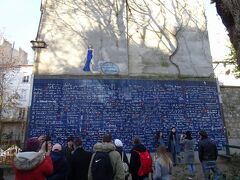
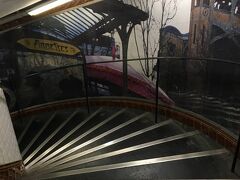








































































































































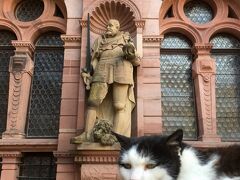
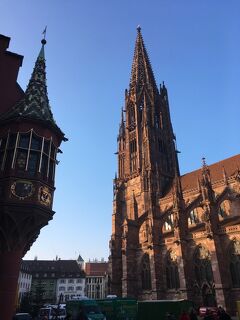
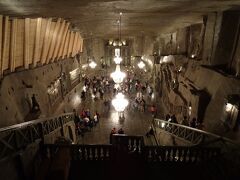

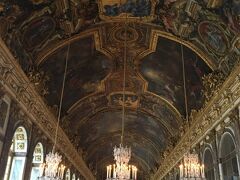
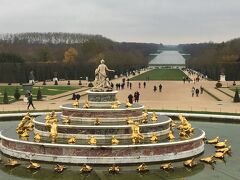
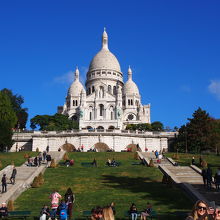


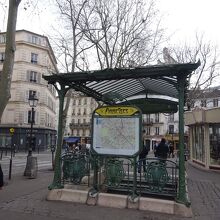




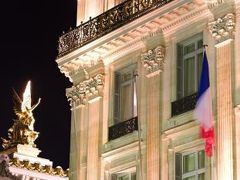
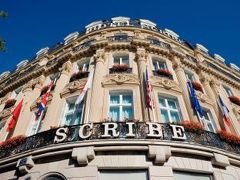






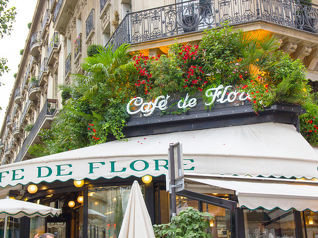
0
133